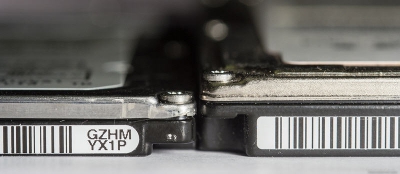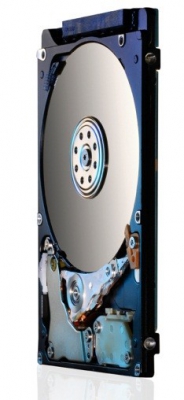
That is why I would like to pay particular attention to such drives. “Less two mm” — is not a revolutionary change, but slim drives appeared on the market at the right time. Already now, thanks to them the number of hybrid storage (SSD + HDD) models on the market rapidly increases. That provides speed, capacity and just laptops with fast and efficient hard drive. Such models don’t cost much (though SSD became slightly cheaper, they still have high margin) and don’t make the owner to carry an external storage device along – just in case he/she wants to selects something from his/her video library. And now short historical background.
Our size?
All modern computer history (after the moment when it required a truck to move one hard drive) is accompanied by two main shape factors – 3,5 inches (legacy of Floppies) for PCs and 2,5 inches – for laptops. However, there were exceptions, for example, 5.25-inch hard drives that appeared at the beginning of 80-ies and shortly revived in the mid 90-ies. There was a time when 3-inch shape factor had been considered for laptops – a compromise between capacity and size, that didn’t work out. 1.8-inch hard drives and less disappeared jusr recently – such tiny thing can be fitted anywhere, only small platters neither ensure data transfer speed nor capacity.
That is why 2.5-inch hard drive is a standard size for mobile devices. Although, why only for mobile? Similar hard drives are used in external storage devices (3,5-inch boxes do not correspond to the meaning of “portable hard drive”), in play stations and in corporate data storage systems. It means that research facilities (not many of them to date) of all manufacturers will be paying more attention towards this format than to standard 3.5-inch models.
So what HGST offers?
Model Travelstar Z7K500 at present is available in modification with capacity 250, 320 and 500 gigabytes. General features of all versions are as follows:
Interface: SATA 3 6 Gb/s
Data buffer: 32 MB
Spindle rotation speed: 7200 RPM
Seek time: 13 ms
Load/unload cycles: 600,000
Read/write power consumption: 1,8 W
Performance idle power consumption: 1,7 W.
All models have one platter for data read/write and at present are one of the fastest laptop hard drives (over 130 Mb/s according to consecutive read/write test). But what’s more important is not speed, its power consumption indicators. In read/write mode the energy input is only 1,8 W.
2 mm is a lot!
No, of course for 8 cm thick monsters slimmer hard drive will have little clout. But for ultrabooks – quite enough. Thickness of modern ultrabook models is from 17 to 21 mm. In such models every millimetre counts, that is why around half of instances use only SSD with capacity up to 128 Gb. In the rest of the cases one hard drive is used or hybrid storage that provides both speed and capacity and at the same time preserving minimum size and weight. There are even 15-inch computers with 1,8 kg of weight. Everyone who always carries computer along know that these laptop parameters require further reduction. Slim hard drives is one of the technologies that allows doing it without need to know how to start hibernation in Windows or swap file (or other wise nothing will fit :).
What’s next?
Slim hard drives allow ultrabook and compact models owners not to limit themselves in the volume of stored data – within reasonable limits but at the same time without limitations of typical SSD for 128 Gb. Of course, these days you can purchase a laptop with 750 Gb and over SSD but it will have a relevant price. Expansion of models with hybrid storage removes the speed issue. Moreover, such models like Z7K500 ensure rather fast data transfer to the hard drive and back maintaining speeds of over 120 Mb/s on “large” files.
As a result, cutting the height of hard drive by 2 mm only extends the life of hard drives. If it seems to someone that just a little bit more time and there will be only solid state drives, it is not gonna happen :) Moreover, even 7 mm is not the limit. Just recently new five-inch hard drives with capacity up to 500 Gb have been announced.
Competition between SSD and HDD will continue and we will only reap its fruits. Among all available laptop disk system configurations personally for me the most beneficial is 80 Gb solid state drive and 500 Gb, always available “archive” with all necessary files. What about you?




